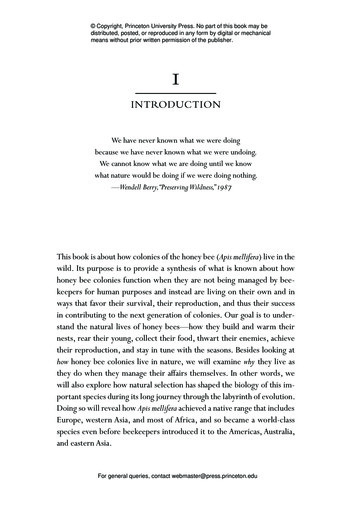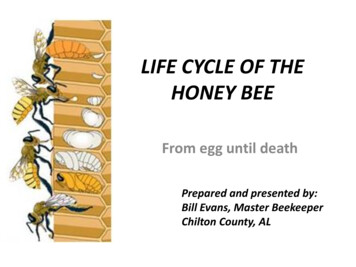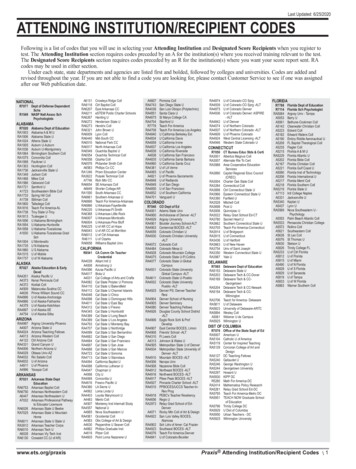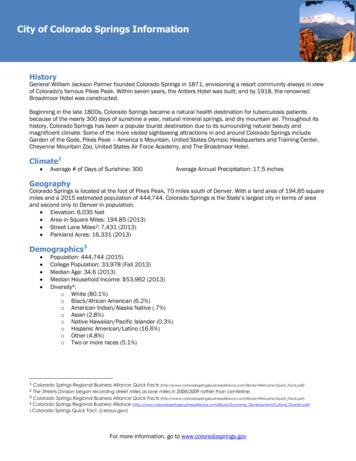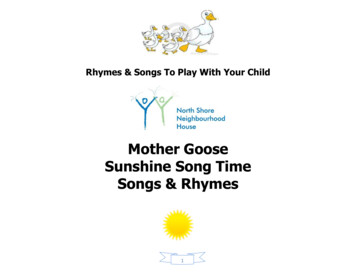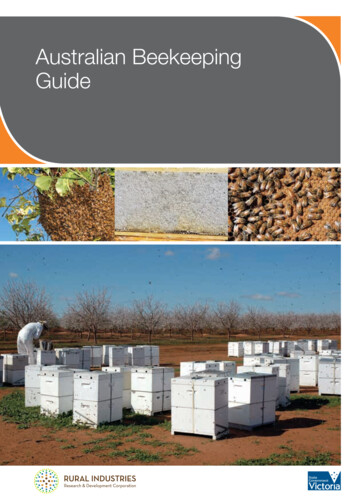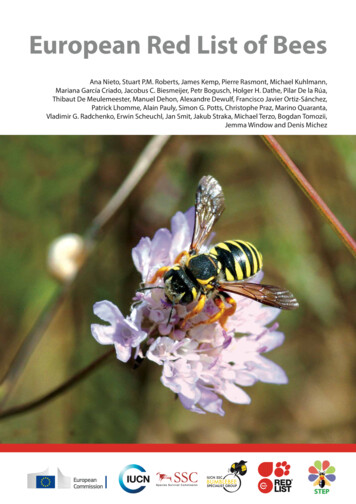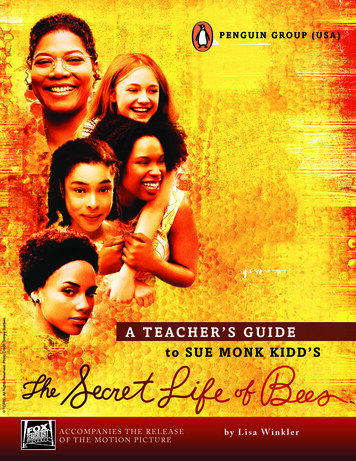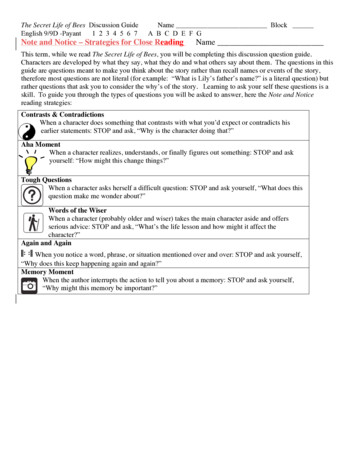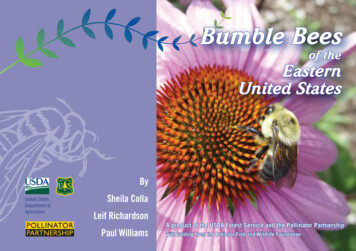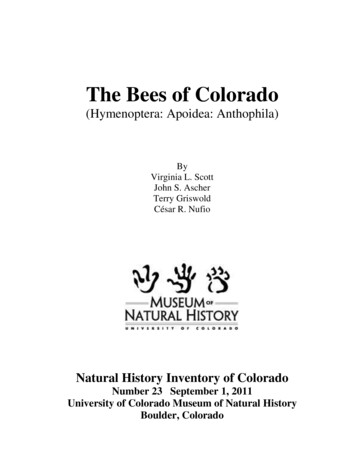
Transcription
The Bees of Colorado(Hymenoptera: Apoidea: Anthophila)ByVirginia L. ScottJohn S. AscherTerry GriswoldCésar R. NufioNatural History Inventory of ColoradoNumber 23 September 1, 2011University of Colorado Museum of Natural HistoryBoulder, Colorado
2011 by University of Colorado Museum of Natural HistoryAll rights reserved.ISSN 0890-6882University of Colorado Museum of Natural History218 UCBBoulder, Colorado 80309-0218
The Bees of Colorado(Hymenoptera: Apoidea: Anthophila)ByVirginia L. Scott1John S. Ascher2Terry Griswold3César R. Nufio1, 41Entomology Section, University of Colorado Museum of Natural History,265 UCB, Boulder, Colorado 80309-0265; virginia.scott@colorado.edu2Division of Invertebrate Zoology, American Museum of Natural History,Central Park West at 79th Street, New York, New York 10024-519234USDA-ARS Bee Biology and Systematics Laboratory,Utah State University, Logan, Utah 84322-5310Department of Ecology and Evolutionary Biology, University of Colorado,334 UCB, Boulder, Colorado 80309-0334Natural History Inventory of ColoradoNumber 23 September 1, 2011University of Colorado Museum of Natural HistoryBoulder, ColoradoISSN 0890-6882
For Urli
Plate 1. Colorado Bees1. Colletes sp., .2. Hylaeus (Hylaeus) leptocephalus (Morawitz), .3. Andrena (Callandrena) helianthi Robertson, .4. Halictus (Pachyceble) confusus arapahonum Cockerell, .5. Agapostemon (Agapostemon) femoratus (Crawford) or A. (A.) obliquus (Provancher), .6. Stelis (Dolichostelis) rudbeckiarum Cockerell, .7. Megachile (Xanthosarus) sp., .8. Coelioxys (Boreocoelioxys) sp., .9. Ceratina (Zadontomerus) sp., .10. Nomada utahensis Moalif, .11. Holcopasites calliopsidis Linsley, .12. Bombus (Thoracobombus) fervidus (Fabricius), .Photographs by Diane M. Wilson.ii
Plate 1.123456789101112iii
.iv
Table of ContentsPlate 1. iiiAbstract . 1Introduction . 1Compiling the Colorado Bee List . 2Problematic Taxa . 4Fossil Bees . 5History of Bee Research in Colorado . 5Contributors . 6Current and Future Research . 11Importance of Voucher Specimens . 12Colorado Bee Diversity. 13Bee Species Diversity in Comparison to Other States . 13Collecting Biases and Areas for Future Study . 14Native vs. Introduced Species . 16Bee Biology . 16Life Cycle of a Bee . 17Solitary, Social, and Parasitic Bees. 18Nesting Biology . 20Floral Associations. 21The Colorado Bee List . 23Colletidae . 23Halictidae . 26Andrenidae . 33Melittidae . 45Megachilidae . 45Apidae . 57List of Problematic Taxa . 73Table of Natural History Traits for Colorado Bee Genera . 78Acknowledgements . 82References . 83v
vi
AbstractThe Colorado Bee List contains 946 valid extant bee species in 66 genera. Distributional data arepresented at the county level for each bee species found within Colorado. The history of beeresearch in Colorado is reviewed and important contributors are noted. Gaps in our currentunderstanding of the Colorado bee fauna are discussed. Colorado bee species diversity is assessedin relation to the faunas of other states, including those adjoining Colorado. Life historycharacteristics, e.g., aspects of sociality, nesting biology, and floral associations, are summarized forColorado bees at the generic level. The literature on fossil bee species known from Colorado issummarized. Megachile helianthi Cockerell is recognized as a junior synonym of Megachile(Megachile) montivaga Cresson, new synonymy. The parasitic species Lasioglossum (Dialictus)sitocleptum Gibbs is recorded for the first time from the United States, and 47 species are recordedfor the first time from Colorado.IntroductionBees are a species-rich group with over 19,500 described species worldwide (Ascher and Pickering2011; Integrated Taxonomic Information System 2009; Michener 2007). While bees occurthroughout the world, they reach their greatest diversity in regions with arid or Mediterraneanclimates (Michener 1979). In America north of Mexico, there are approximately 3,500 describedbee species (Ascher and Pickering 2011; Hurd 1979). The number of described species, however, isonly a portion of the actual total, as many additional undescribed species are known to exist. This iseven true for relatively well-studied areas such as the United States, including Colorado.Bees are biologically and ecologically diverse and provide essential pollination services in natural,urban, and agricultural systems (Kearns et al. 1998; Kremen et al. 2002; National Resource Council2007; Winfree et al. 2008). Changes in bee faunas due to alteration in land use, pesticideapplication, or reduction in suitable habitat may have profound effects on ecosystem processes(Kearns et al. 1998; Williams et al. 2009; Winfree et al. 2009).To better understand the biology and roles of bees and to inform guidelines for their conservation, itis essential to have a baseline understanding of bee diversity and distribution. In creating theColorado Bee List (page 23), we compiled records from natural history collections and publishedliterature that inventory all extant bee species known from Colorado. While previous surveys andregional inventories exist for parts of Colorado (Cockerell 1906c, 1907b, 1910, 1919, 1930) andmany Colorado records are listed in numerous taxonomic revisions (including those cited below inthe Colorado Bee List) and catalogs (e.g., Hurd 1979; Moure and Hurd 1987), this is the firstdetailed, comprehensive, statewide listing of Colorado bee species.The goals for producing the Colorado Bee List are: 1) to provide a taxonomically current inventoryof the bee species and subspecies that occur in Colorado, 2) to provide county-level informationabout each species’ distribution within the state, 3) to review the history of bee collecting andresearch in Colorado, noting important contributors, and 4) to provide a baseline resource forconservation and pollination biologists and other researchers working on a broad range of beerelated studies. To increase the utility of this inventory we also consider the diversity of Coloradobees in a broader context by summarizing some of their important life history traits.1
Compiling the Colorado Bee ListThe Colorado Bee List (page 23) documents 946 valid living (modern) bee species in 66 generarecorded from the state. A total of 141 subspecies are listed for the 108 Colorado species that havemultiple subspecies over their range. Eighty of the 108 polytypic species have one subspecies listedfor Colorado, twenty-five species have two subspecies in Colorado, two species have threesubspecies in Colorado, and one species has five subspecies in Colorado.The information in this list reflects over a century of bee research and is based primarily onspecimen data from the University of Colorado Museum of Natural History, Boulder, Colorado(UCMC), the C.P. Gillette Museum of Arthropod Diversity, Colorado State University, FortCollins, Colorado (CSUC), the American Museum of Natural History, New York, New York(AMNH), and the United States Department of Agriculture, Agricultural Research Service, BeeBiology and Systematics Laboratory, Logan, Utah (BBSL). Available georeferenced specimenrecords used here include 3,691 records from the AMNH Division of Invertebrate Zoology database(Schuh et al. 2010), 5,938 records from the BBSL database, 930 specimens from the University ofCalifornia Riverside Collection (UCRC) database, and 229 specimen records from the collections ofthe Rocky Mountain Biological Laboratory (RMBL). A few significant records from the SnowEntomological Collection at the University of Kansas Museum of Natural History (KSEM) wereincorporated as well. Records for Bombus only have been included from the Los Angeles CountyMuseum (LACM), the Bohart Museum of Entomology at the University of California Davis(BMEC), the C. A. Triplehorn Insect Collection at the Ohio State University (OSUC), theUniversity of Minnesota Insect Collection (UMSP), and the University of Wyoming Insect Museum(ESUW).In addition to specimen data from these natural history collections, species occurrence informationwas obtained from numerous taxonomic revisions, regional inventories, and species descriptions.For published records that we considered questionable or problematic based on our currentunderstanding of taxonomy and distribution, we attempted to locate corresponding specimens toconfirm or reidentify. If specimens could not be located to document questionable publishedrecords, we indicated this on the list.In a few cases, we obtained significant occurrence data from photographs posted online atBugGuide (www.bugguide.net, accessed 2011). These photos were of sufficient quality andshowed diagnostic characters, thus allowing for species identifications by the authors of this paper.While photos of live bees cannot take the place of specimens, they can document species from siteswhere collecting is restricted, floral associations, nesting sites, and other aspects of bee life history.The hierarchical classification of family-group names, i.e. families, subfamilies, and, whereapplicable, tribes and subtribes, follows Engel (2005) with minor modifications: supertribes are notcited; no tribes are recognized in Hylaeinae; subtribe Caenohalictina is included within the tribeHalictini with Agapostemonina treated as a junior synonym; subtribe Sphecodina is treated as asynonym of Halictina; Augochlorini is listed prior to Halictini; Andrenini is recognized as a tribewithin Andreninae; Panurginina is recognized as a valid subtribe of Panurgini; Macropidinae isreduced to tribal rank within Melittinae; Hesperapini is treated as a tribe separate from Dasypodaini;Lithurginae is reduced to tribal rank within Megachilinae; Dioxyini is treated as a tribe separatefrom Anthidiini and is cited prior to it; no subtribes are recognized for Osmiini; and Exomalopsinifollowed by Emphorini are listed prior to Eucerini.2
Generic and subgeneric classification generally follows Michener (2007) with some exceptions.Protandrenine classification follows Ascher (2004), Ascher and Pickering (2011), and Giles andAscher (2006); see also Mitchell (1960). We prefer to recognize the genus Protandrena sensuTimberlake (1976), but also include Metapsaenythia (the type species only) as a junior synonym.Genus Protandrena sensu lato of Michener (2000, 2007) is heterogeneous and likely paraphyletic,as it includes a variety of South American taxa quite different from Protandrena sensu Timberlakebut excludes Pseudopanurgus sensu Timberlake (1973) which is similar to Pterosarus and likelybelongs to the same clade (Ascher 2004). In addition to recognizing subgenera, we also recognizeformal species groups within many genus-group taxa, most of which have precedents in theliterature (e.g., Hurd 1979), although in many cases they have not been widely used. Certainspecies groups are newly proposed, as in the case of Sphecodes where we follow an unpublishedinfrageneric classification provided by M.S. Arduser (pers. comm.).Genera and subgenera are listed alphabetically within their family-group taxa. For each genus, wecite revisions and other pertinent literature. Species and subspecies, where applicable, are listedalphabetically within their genus, subgenus, or species group, where applicable, and are cited withauthor(s) and year of valid publication for nomenclatural purposes, with the imprint date cited inbrackets and within quotation marks if this differs.The nomenclature used in the Colorado Bee List represents the current valid species names (Ascherand Pickering 2011). Junior synonyms are not mentioned in the list, except in a few instances (inbrackets following the valid name) where recent synonymies or those made in obscure referencesare not yet in general use. One new synonymy is proposed herein, as the holotype female ofMegachile helianthi Cockerell in the American Museum of Natural History was studied by JSA andproved to be synonymous with the well-known Megachile (Megachile) montivaga Cresson (see theColorado Bee List) rather than being a valid species of subgenus Sayapis.For each listed species, we provide information on the Colorado counties (Figure 1) where thatspecies has been collected. In the case of species for which specific locality information is lackingbut a valid Colorado record exists (sometimes based on older type material), we note that thespecies occurs in Colorado. In cases where a locality could not be located with certainty or thelocality extends into two or more counties (e.g., Rocky Mountain National Park), the locality nameis listed verbatim with no attempt to assign a county.Field notes, including those of U.N. Lanham (at UCMC) and the C.P. Gillette Accession Volumes(at CSUC), were crucial for determining many county records. Paxson (1906) provides aninteresting history of Colorado and its counties from 1861 when Colorado became a territory,through statehood in 1876, and continuing until 1905 when all but three (Broomfield, Jackson, andMoffat) of Colorado’s current counties had been defined (although Denver County was enlargedwhen Denver International Airport was constructed in the early 1990s).A variety of web-based tools were also used to identify historical localities including:Colorado Places by County, COGenWeb: http://cogenweb.com/coplaces/GoogleEarthTopozone, previously available at http://www.topozone.com/USGS Board on Geographic Names: http://geonames.usgs.gov/domestic/index.html3
Figure 1. Relief map showing Colorado counties (based on a map from geology.com).Although the Colorado Bee List reflects an extensive examination of specimens and literature, werecognize that this is a provisional list of the bee fauna of Colorado. As research progresses, weanticipate new synonymies, descriptions of new species, and range extensions or modifications.This current list includes species that will soon be relegated to synonymy as revisions are published,and it does not include undescribed species that are currently known to the authors. The authors arealso aware of more than 150 additional described bee species that potentially occur in Colorado.These are species with known distributions that straddle Colorado (e.g., occurring in New Mexicoand Wyoming) or documented in a neighboring state within twenty miles of the Colorado state line.These species are not included in the Colorado Bee List since they are not currently documentedfrom the state. After further study, it is quite possible that the number of bee species in Coloradomay approach 1,100 species.Problematic TaxaSpecies were considered problematic when their occurrence as established members of theColorado bee fauna was questionable. Thirty-one species are detailed in the List of ProblematicTaxa (page 78) and fall into one of three main categories.1. Published records based on misidentifications – In compiling the Colorado Bee List, weencountered published records of uncertain validity for species otherwise unknown in Colorado.4
We attempted to locate the specimens that were the basis of these published records. Some weredetermined to be misidentifications based on current taxonomic knowledge. Rather than ignorethese species, we opted to address them in the List of Problematic Taxa.2. Unverifiable identifications – Some museum specimens seemed out of range even though theywere identified by a relevant expert in the past. Further taxonomic study may validate theseidentifications. Unfortunately, at this time, no one is able to confirm some western U.S. speciesbelonging to taxonomically difficult genera such as Lasioglossum, Sphecodes, and Nomada.3. Accidental occurrences – There are several correctly identified specimens documenting adisjunct occurrence in Colorado of species that are not considered to be established members of theColorado bee fauna. These are listed with details about their identification, collection, and labeling.Fossil BeesWhile this paper focuses on the extant bees of Colorado, we would be remiss if we did notsummarize the literature on fossil bee work in Colorado. Research on Colorado’s fossil insectsdates back to the early 1870s when Samuel H. Scudder ventured west as part of the Hayden Survey.Scudder collected and described numerous Colorado fossil insects from the Florissant and GreenRiver Formations (see Scudder 1878, 1886, 1890, 1891). In the early 1900s, T.D.A. Cockerellbecame interested in Colorado fossil insects and collected additional fossil material at Florissant. In1906 and 1907, S.A. Rohwer joined Cockerell at Florissant. Fossil bee species described byScudder and Cockerell are catalogued by Zeuner and Manning (1976). F.M. Carpenter includesinformation on Colorado fossil bees in his Treatise on Invertebrate Paleontology (Carpenter 1992).Engel (2001a, 2002) described additional bee species from Florissant. Engel (2001b) and Grimaldiand Engel (2005) commented on Florissant bee fossils and noted the great difficulty of makingprecise identifications of species preserved in these compression deposits. Meyer (2003) illustratedFlorissant fossils and listed 31 described bee species from the Florissant Formation. Variousadditional fossil bees are known, but have yet to be published (M.S. Engel, pers. comm.).Fossil insects continue to be collected and studied in Colorado. Current excavations are beingundertaken at the Florissant Fossil Beds National Monument (late Eocene), in the Green RiverFormation of northwestern Colorado (middle Eocene), and at several smaller sites across the state(Eocene and Oligocene) (D. Smith, pers. comm.).History of Bee Research in ColoradoResearch on extant Colorado bees spans more than a century. Early work on Colorado bees focusedon taxonomic descriptions of species, species inventories for discrete areas (e.g., Boulder,Florissant, Mesa Verde), and life history studies of particular taxa. The collections associated withthese early studies remain important for taxonomists who continue to describe and reevaluatespecies, for systematists who are interested in the evolutionary relationships within and among beetaxa, and increasingly for ecologists, conservation biologists, and pollination biologists who requirebaseline data on Colorado bees.5
Bee research in Colorado over the last thirty years has included investigations of the ecology ofpollinator-plant interactions studied in the context of the conservation of rare plants (Karron 1987;Lewinsohn and Tepedino 2007; Sipes and Tepedino 2006; Tepedino et al. 1999), the effects ofpollinators on the genetic structure of communities (Bingham and Orthner 1998; Williams et al.2001), pollinator efficiency (Catling and Catling 1989; Graham and Jones 1996; Kearns and Inouye1994), the effects of nitrogen on plant-pollinator networks (Burkle and Irwin 2009, 2010), and thepollination biology of montane and alpine flowers (Burkle et al. 2007; Elliot and Irwin 2009; Galen1989; Galen and Geib 2007; Jones et al. 1998; Maloof 2001; Newman and Thomson 2005; Suzuki1994) and other plant communities (Bingham 1999; Eickwort et al. 1996; Graham and Jones 1996;Macior 1970, 1974; Moldenke and Lincoln 1979).The history of bee research in Colorado has been documented by an impressive number ofvouchered specimens that reside in natural history collections within the state. Many of thesespecimens are housed in the entomology collection at the University of Colorado Museum ofNatural History in Boulder (UCMC). Over 70,000 bee specimens at UCMC were collected inColorado between the early 1900s and the present (an additional ca. 30,000 bee specimens werecollected outside Colorado during this time).Collections at the C.P. Gillette Museum of Arthropod Biodiversity at Colorado State University(CSUC) contain over 65 fully packed drawers of bee specimens, mostly from Colorado. These beesdate back to the late 1800s. Since 1986, curator Boris Kondratieff and his associates havecontinued to build the collections at CSUC by actively collecting bees and other insects throughoutColorado.Additionally, many thousands of specimens from Colorado reside in the AMNH and in the BBSL.Other collections that have significant Colorado holdings include the National Museum of NaturalHistory, Smithsonian Institution (USNM), Snow Entomological Collection at the University ofKansas Museum of Natural History (KSEM), Cornell University Insect Collection (CUIC),University of California Riverside Collection (UCRC), Rutgers University Arthropod Collection(RUIC), Rocky Mountain Biological Laboratory (RMBL), and the Rebecca Irwin Laboratory atDartmouth College. Early collections described by E.T. Cresson reside at the Academy of SciencesPhiladelphia (ANSP).ContributorsThe following list summarizes significant bee collectors and researchers, arranged more or less inchronological order. Ewan (1950) documents early naturalists, including entomologists, working inthe Rocky Mountains. These naturalists included both scholars that lived and worked in the areaand adventurers who made one or several significant expeditions into the Rocky Mountain states.The following section draws heavily from this work and also from McClurkin (1935) and Mallis(1971).Thomas Say (1787-1834) was a taxonomist who described nearly 1,400 insects and was a foundingmember of the Entomological Society of America. Say is considered to be the first entomologist toventure into the Colorado region, accompanying Major Stephen H. Long on his expedition to theRocky Mountains in 1819-1820 and collecting insect specimens that he later described (Say 1824,1837).6
James Ridings (1803-1880), a native of England, settled in Philadelphia and helped found theEntomological Society of Philadelphia (American Entomological Society). He made a collectingexpedition through Kansas and the eastern portion of the Colorado Territory in 1864. On this trip, itis reported that he traveled to Burlington, Colorado in Boulder County. It should be noted that thisBurlington is the city now known as Longmont (Brown 1966) and not the current city of Burlington(Kit Carson County) established in 1887 (and incorporated in 1888). Several dozen bee speciescollected by Ridings on his Colorado expedition were later described by Cresson (1878a, 1878b,1879a).Herbert K. Morrison (1854-1885), originally from Cambridge, Massachusetts, was a renownedinsect collector who traveled extensively collecting Lepidoptera and other insects (Mann 1885).His travels took him to the Colorado Territory in 1874 where he collected, among other things, beesthat were later described by Cresson (1878a, 1878b, 1879a).Ezra T. Cresson (1838-1926) was a Philadelphian and one of the founding members of theEntomological Society of Philadelphia (American Entomological Society). He specialized inHymenoptera taxonomy, including species from the western U.S., and described 196 of the taxa inthe Colorado Bee List, including species collected by Ridings and Morrison (Cresson 1872, 1878a,1878b, 1879a, 1879b). Many of these specimens reside at the Academy of Natural Sciences inPhiladelphia (ANSP). Incidentally, Cresson was James Ridings’ son-in-law.Francis H. Snow (1840-1908) was a professor of mathematics and natural science and ultimately achancellor at the University of Kansas. Between 1876 and 1907, Snow took students on annualsummer collecting trips, twenty-six expeditions in all, through various western states, includingmultiple trips to Colorado. On these trips, he and his students amassed huge numbers of insectspecimens that are currently housed at KSEM. Although not a taxonomist, his collections wereextensive and have contributed greatly to insect and bee taxonomy.Clarence P. Gillette (1859-1941) was an entomologist with the Colorado Agriculture College(Colorado State University) and, beginning in 1891, was in charge of the Colorado ExperimentStation in Fort Collins. He was an avid collector and founder of their insect collection (CSUC).That collection, which now bears his name, includes some of the oldest Colorado bee specimenshoused in Colorado.Charles F. Baker (1872-1927) was an assistant entomologist who worked with Gillette at theColorado Experiment Station in Fort Collins from 1892 to 1897. CSUC houses many Bakerspecimens. It should be noted that in 1899 Baker collected many insect and plant specimens from“Los Pinos”, Colorado. Historically, there have been several localities in Colorado that use thissame name including a train stop on the Cumbres and Toltec Railroad in Conejos County ca. 9,700ft., but it is clear that in 1899 Baker was at the Los Pinos (established in 1889) that is the area nowknown as Bayfield (renamed in 1899) in La Plata County ca. 7,000 ft. (Tiehm 1989).Theodore Dru Alison (T.D.A.) Cockerell (1866-1948), a native of England, first arrived inWestcliffe, Colorado in 1887 after contracting tuberculosis. After three years living in the WetMountain Valley of Colorado, he returned to his birth country. His route back to Colorado includedresidences in Jamaica and New Mexico. Upon his return in 1903, he worked first as curator of themuseum at Colorado College in Colorado Springs, then as a professor at the Boulder PreparatorySchool and a lecturer at the University of Colorado, and finally as a professor of zoology at the7
University of Colorado until his retirement in 1934 (Weber 1965, 2000). His Colorado bee workbuilt upon his previous studies of New Mexico bees begun in the 1890s, where his first encounterswith the highly diverse and very poorly known bee fauna of western North America inspired hislifelong interest in describing bees and investigating their biogeography. Professor Cockerell, withthe help of his second wife, Wilmatte Porter (W.P.) Cockerell, collected extensively and publishedprolific works on bees (as well as many other subjects). While he studied bees from around theworld, he also published a number of regional Colorado bee studies, including the bees ofFlorissant, Teller County, Colorado (Cockerell 1906c), which listed 119 species. In the bees ofBoulder County, Colorado (Cockerell 1907b), his species list totaled 183 species, including thoselisted in the postscript, but he estimated the total number of species in Boulder County to exceed300. Other works, including Cockerell (1905, 1910, 1916, 1919, 1921, 1922b, 1923, 1929b, 1930,1931, 1933a, 1934), Cockerell and Robbins (1910), and Cockerell and Blair (1930), focused onColorado bees. Cockerell was an avid taxonomist, describing 6,401 bee species and subspeciesworldwide (Zuparko 2008). Of the 946 species (and 57 non-nominate subspecies) listed in theColorado Bee List, Cockerell described 412 as sole author or coauthor. For a full bibliography ofCockerell’s 3,904 publicat
Entomological Collection at the University of Kansas Museum of Natural History (KSEM) were incorporated as well. Records for Bombus only have been included from the Los Angeles County Museum (LACM), the Bohart Museum
